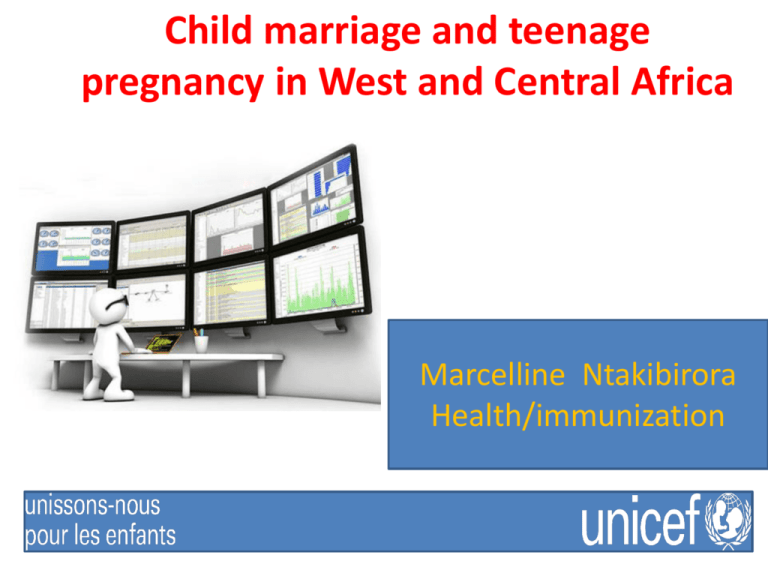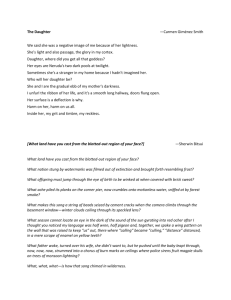Child marriage and teenage pregnancy in West and Central Africa
advertisement

Child marriage and teenage pregnancy in West and Central Africa Marcelline Ntakibirora Health/immunization Background • Skilled birth attendance ( 2011) 42 % girls (26% in urban areas, 53% in rural areas) are married before the age of 18 .70% of girls are married before reaching the age of 18.In Niger, Chad and Mali 1 in 3 women are married before turning 15 High fertility and population growth rates, as well as high maternal, infant and child mortality and morbidity rates Child marriage (2007&2011) The average age of marriage has increased very slowly in West and Central Africa Declines in child marriage by 10% or more (between two MICS or DHS surveys) in : Ghana, Liberia, Mauritania and Sierra Leone Rationale Burkina Faso, Niger, Senegal and Sierra Leone are addressing child marriage and teenage pregnancy from a variety approaches : advocacy for legal reforms, community mobilisation and promotion of reproductive health. • Recognized need for more region-specific research to understand what factors lead to a decrease in child marriage and teenage pregnancy, as well as robust evaluations of the programming in this field Rationale staffs exposed to this program on advances in Social Norms and Social Change, an increased understanding that child marriage is often upheld by social norms Region to explore how societal forces, such as social acceptance can play a role in the decline of both child marriage and teenage pregnancy so that they can be leveraged to promote a decline in both. Child marriage: social Norm? Custom: this has been going on with our forefathers, … Religion recommends chastity before marriage, ought to make sure my daughter makes it : Moral The factual beliefs: my daughter may lose virginity, her chances to get a good husband vanishes honourable families married their daughter at puberty age to prevent having sexual activity out of marriage, (empirical expectations), and they also ought do the same (normative expectations) Child marriage: social Norm? pregnancy out of wedlock is a shame for the mother and disgrace for the family (social sanction). For his honour, the father can kick the mother and her daughter out of his home; he disowns his daughter and the mother is held responsible for her daughter’s bad behaviour (gender issue). • mother believes that she ought to marry her daughter as earlier as possible (normative personal belief, Child marriage: social Norm? pregnancy out of wedlock is a shame for the mother and disgrace for the family (social sanction). For his honour, the father can kick the mother and her daughter out of his home; he disowns his daughter and the mother is held responsible for her daughter’s bad behaviour (gender issue). • mother believes that she ought to marry her daughter as earlier as possible (normative personal belief) Child marriage: social Norm? • Families prefer to give their daughter in marriage earlier (conditional preference) to protect their honour and conform to the common practice though mothers may be aware of the risk of abuse by co-spouses (she probably went through the same situation). • Parents prefer to conform to the practice because they believe that most of the families around believe and do the same (social expectation) and expect them to stick to that collective behaviour . Child marriage: social Norm? • Pregnancy out of wedlock is a shame for the mother and disgrace for the family (social sanction). • For his honour, the father can kick the mother and her daughter out of his home; the father disowns his daughter and the mother is held responsible for her daughter’s bad behaviour (gender issue) “A wise son makes a glad father but a foolish son is the grief of his mother (Proverbs 10:1, NKJV)” The study has to look at The enabling factors in the country where slight changes have occurred: • the role of extra-social factors (economic, legal, political, religious, health or educational services, technological) in the shift • Role of urbanisation ( change in community interaction and dependency) • the methodologies used: community deliberation (Tostan), law, communication and media campaign The study has to look at the normative influences and approaches that can be used to get the family understand that a girl can be married later and still respect the religion and procure honour. Because of interdependence in the community, the study has to undertake a thorough analysis of the reasons of this practice but bearing in mind that they can differ from a community to another The study in 4 to 6 countries) basically to take stock of what has been done, learn from it and suggests better approaches. ( cultural groups/ trans border) . The study has to look at In addition the diagnostic of the collective behaviour has to be done to identify the changes needed and the ways to handle them With regards to social norms, the study has to determine: • what is the reference network (Individuals ,Groups ,structure, characteristics, relationship, ties( weaknesses and strengths) , nodes, edges, bridges ) which sustains the mutual social expectations of letting a child marrying , • the conditions under which the norm is obeyed in order to design a strategy of changing them • identify the approach to change social expectation and create a new norm within the network Methodologies • Data available collected through DHS and MICS using KAP and focus group methodologies. • MORES and health facilities data ( age of first pregnancy) • For social norms assessment, there is need of other methodologies such vignettes but also fields experiments • Specific resources internal or external to contribute to questionnaire designing and surveyors training based on the algorithm: “understand under which conditions people will marry chidren” Areas to be assessed Examples of questions Ask actors about their beliefs about child marriage (empirical expectations): e.g: Do you believe most of the parents believe that marry their daughter at early age is a good thing to do? How many parents do you believe would marry their daughter early • Hypothetical questions (about what will happen if reference network stop to marry daughter at young age ) : e.g in Senegal, what will happen if “ pheuls “in Mali abandon marrying their young daughter? Your brother? Your friend? The chief? What will you do if the Imam advises to stop? • Check what individuals would do under different information conditions e.g: if you were offered option to send your daughter in a school to become a doctor, what would do? If the custom could allow to secure a husband for your daughter , will you stay with her till her maturity? Teen pregnancy ..early marriage • 2 studies or one? Target: young girl, same actors, different circumstances and conditions ( EE& NE) Pregnancy in wedlock ….accepted , Child marriage abandonment will reduce teen pregnancy But additional approaches needed to end teen pregnancy Network and references are different





